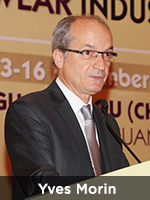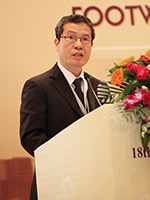Hosted for the first time by China, the UITIC Congress put the spotlight on complex matters that are becoming highly topical and include various issues such as sustainability environment, work conditions, training and technological innovation. Experts from all over the world spoke about the questions from many points of view
At first sight Corporate Social Responsibility might seem a further burden on production, added expenditure for firms, but in reality it represents a great opportunity for growth at a time in which the world manufacturing industry is having to face challenges such as progressive increase in costs of labour and raw materials. Through this Congress we aim to offer instruments for better understanding the matter, of which consumers all over the world are increasingly more aware
explained UITIC chairman Yves Morin, who is also CEO of French technical centre CTC Group, in his opening speech.
 The importance of the event was underlined also by the fact that for the first time the footwear technicians’ congress was held in China, impeccably organized by the China Leather Industry Association (CLIA) that unites Chinese producers of leather, footwear and accessories, which recently joined the UITIC that now includes 27 countries and represents 90% of the footwear business. After a first day dedicated to visiting the impressive manufacturing units of two local footwear giants, the Huajian Group (located at Dongguan) and Belle Group (in Shenzhen), the congress opened officially in the prestigious framework of Hotel Shangri-La of Guangzhou, that saw the presentation of 37 different works including speeches and posters, by international experts who dealt with numerous issues divided into 5 main sessions: Product innovation, Process innovation, Working conditions and Human resources, Consumers and customers, Business practices and CSR implementation.
The importance of the event was underlined also by the fact that for the first time the footwear technicians’ congress was held in China, impeccably organized by the China Leather Industry Association (CLIA) that unites Chinese producers of leather, footwear and accessories, which recently joined the UITIC that now includes 27 countries and represents 90% of the footwear business. After a first day dedicated to visiting the impressive manufacturing units of two local footwear giants, the Huajian Group (located at Dongguan) and Belle Group (in Shenzhen), the congress opened officially in the prestigious framework of Hotel Shangri-La of Guangzhou, that saw the presentation of 37 different works including speeches and posters, by international experts who dealt with numerous issues divided into 5 main sessions: Product innovation, Process innovation, Working conditions and Human resources, Consumers and customers, Business practices and CSR implementation.
Also there to welcome participants was Liu Suilong, chairman of XINHAOPAN Group, an important manufacturer of footwear materials and exclusive sponsor of the Congress, who declared great confidence in technological innovation to support development of the Chinese shoe industry. CLIA chairman Su Chaoying played host and offered a picture of the Chinese leather industry, dwelling in particular on challenges awaiting in the near future. The progressive rise in labour costs and increasing difficulties in finding skilled personnel in the coastal areas, where average wages are now between 450 and 600 dollars a month (+4.5%), according to the CLIA point to further relocation of production towards the interior that offers lower costs and is therefore more competitive. Because of the weakness of European and American markets, the association predicts that in the coming years the more export-oriented Chinese footwear firms could be forced to seek new outlets (Southeast Asia and Africa) but also to focus more on the domestic market that is expanding rapidly.

China focuses on the domestic market
Su Chaoying, chairman of CLIA
It was a great honour to be able to organize such an important congress in our country
Mr Su, what are the greatest challenges China’s leather trade has to face now?
The progressive increase in labour costs and the difficulty of finding skilled personnel in the more industrialized parts of the country are the major obstacles in developing the sector, together with continual rise in prices of raw material and valuation of the Renminbi compared to trading currencies that obviously diminishes the competition of Chinese products. From this point of view I strongly believe in the contribution new technology can make in limiting production costs and I also feel it important to cooperate with European firms regarding innovation in technology, as well as fashion and design
What opportunity for growth do you foresee in the near future?
In coming years China will focus a lot on the domestic market that is greatly expanding. We expect export to remain stable on the traditional markets of Europe and the United States, while it could increase on emerging markets, especially in Southeast Asia and Africa
 Therefore in the next five years growth rates similar to those of the last decade cannot be expected because firms must focus more on quality and innovation. This points to a strong increment in demand for cleaner technology with reduced consumption of energy and water as well as more eco-friendly chemical products.
Therefore in the next five years growth rates similar to those of the last decade cannot be expected because firms must focus more on quality and innovation. This points to a strong increment in demand for cleaner technology with reduced consumption of energy and water as well as more eco-friendly chemical products.
The basic principles of Corporate Social Responsibility were explained by UNIDO expert Florian Beranek who, apart from conforming to the rules, emphasized the importance of ethical conduct on the part of firms, touching on the principles that inspired the compilation of the UNI ISO 26000:2010, that supplies official guidelines to organizations wishing to operate on the market in a socially responsible manner. Next speaker was the renowned American expert Peter Mangione. After analysis of major Chinese competitors such as Vietnam, India and Ethiopia, the former president of American retailers explained that, despite a slowdown in China’s growth due to increasing costs, there is no other country in the world with the possibilities of setting up the necessary infrastructures like China.
Nevertheless, the American expert pointed out another arduous challenge for China – the progressive evaluation of its currency that obviously diminishes the competition of its products. This is another reason, according to Mangione, to develop the Chinese footwear manufacture for its domestic market, the biggest in the world with an annual consumption of 3.6 billion pairs as against 2.6 billion in Europe and 2.3 in the United States.
The question of sustainability in production was taken up by Sergio Dulio, an Italian engineer among the most expert in innovative footwear technology, who presented an address entitled “Lean, green and clean: a new paradigm in footwear manufacturing”, in which he focused on the policy of producing just what is necessary (in other words only what has been ordered) thus minimizing waste and inefficiency along the whole production line to keep energy consumption as low as possible.
 On the subject of innovative technology, there was an interesting contribution from Michele Cantella of the Italian Atom, a leader in automatic cutting systems, who is considering how to further increase efficiency in this work stage by using anthropomorphic or delta robots to recuperate off-cuts.
On the subject of innovative technology, there was an interesting contribution from Michele Cantella of the Italian Atom, a leader in automatic cutting systems, who is considering how to further increase efficiency in this work stage by using anthropomorphic or delta robots to recuperate off-cuts.
Fashion and sustainability
Yves Morin, chairman of UITIC
I am very satisfied with the results of the Congress, the reports were of a high standard, as well as being comprehensible and clear for everyone. Above all I feel it was very important to introduce to the trade the theme of Social Responsibility and China – which covers 65% of global production – was certainly the perfect spot to begin talking about this issue
Some people think that Social Responsibility (SR) is a marketing instrument to up sales.
I totally disagree. When you talk about footwear you are talking about consumers, you and me, men, women and children: human beings who have the right to products that are both innocuous and increasingly sustainable. We are entering a new era of consumer awareness in which SR requisites are indispensable. In fact, this is already the case in France. We must be prepared
Footwear is closely related to fashion. How do you suggest continual fashion updates can be compatible with issues of environmental impact and sustainability?
In fact, there is a certain conflict between fashion and sustainability, which obviously don’t share the same objectives, but I am convinced that a way can be found to bring the two worlds nearer, shortening the gap, for example focusing more on added value of products
Enrique Montiel of the Spanish research institute INESCOP approached the problem of an increasingly older work force in Europe that poses the necessity of attracting young people to this sector. According to recent studies, in the next few years Europe will lose some 20 million skilled workers. A very interesting speech was offered by Andreas Tepest of the German footwear giant Deichmann that produces some 165 million pairs a year, mainly in Asia, which for years has maintained a strict policy of Social Responsibility that all its suppliers must respect.
An example of virtuous tanning was offered by the German firm Isa Tan Tec that manages two production units in Asia, one in Saigon, Vietnam, and the other at Heshan in China, which represent a model of sustainability thanks to the use of avant-garde technology for energy saving, efficient treatment and recycling of wastes.
Social issues ever more important
Jean-Pierre Renaudin, CEC chairman
Jean-Pierre Renaudin is the new president of the European Footwear Confederation (CEC). From France, for two years a manufacturer of children’s shoes in the Bordeaux area, Renaudin was an extremely keen participant at the UITIC congress.
President, do you think the world is ready to accept the terms of Social Responsibility?
In Europe there is a lot of pressure on this issue by environmentalists whose warnings of catastrophes make a great impression on consumers. In the future we must expect a sort of Reach that will focus on social issues and we must be ready to dictate our own rules. Recently in France the TV has aired many programs which give a negative image of tanning production, talking about leather mistakenly. There is a lot that must be done to actively and positively reverse these messages. I also feel it is very important to have actually started talking in China



